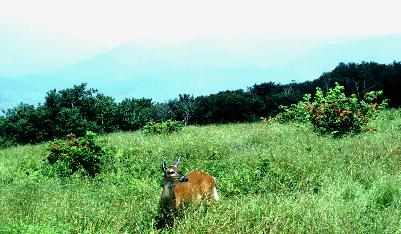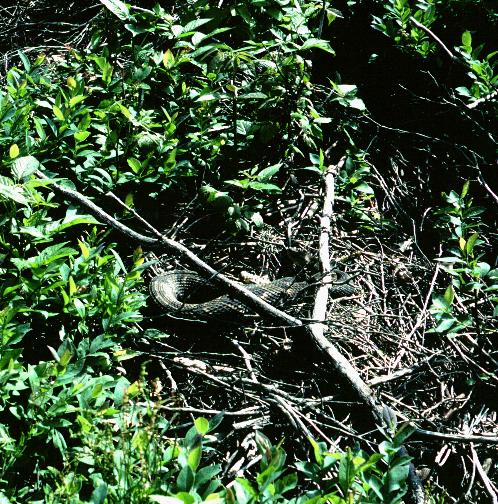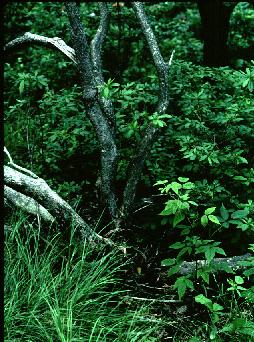 The Park Service has been trying to reclaim Gregory and several other balds, because encroaching scrub and trees are threatening the existence of these areas. We were amazed with the amount of clearing that they had done in only two years, and impressed with the plants that had begun to flower better now that they had more sun. Also, the improved view of Cades Cove from the top is breathtaking, and reminded me of the opening to the motion picture, "Sound of Music", where Julie Andrews sings the title song in a meadow surrounded by mountains. My hiking companions laughed at me as I sang a few bars of the refrain. Naturally I was missing the orchestra accompaniment, but then Julie Andrews didn't have azaleas.
The Park Service has been trying to reclaim Gregory and several other balds, because encroaching scrub and trees are threatening the existence of these areas. We were amazed with the amount of clearing that they had done in only two years, and impressed with the plants that had begun to flower better now that they had more sun. Also, the improved view of Cades Cove from the top is breathtaking, and reminded me of the opening to the motion picture, "Sound of Music", where Julie Andrews sings the title song in a meadow surrounded by mountains. My hiking companions laughed at me as I sang a few bars of the refrain. Naturally I was missing the orchestra accompaniment, but then Julie Andrews didn't have azaleas.
All is not perfect on Gregory, though. One concern I had this time was the presence of deer, nearly tame and apparently accustomed to the public. I could practically pet them as they chewed away on grass, wildflowers, and yes, azaleas. Having seen what deer have done in many eastern gardens, I was concerned that in future years they might devastate the horticultural treasures on the bald. My feeble shouts at the deer to stop eating certain azaleas went unheeded; they looked at me with no concern. I do hope that the deer population won't be frequenting the mountaintop in winter, which is when they seem to do most of their damage in our area.
|

Deer Grazing on Bald
|

Rattlesnake in Brush
|
|
We came across the other hazard on Gregory as the three of us were strolling aimlessly among these glorious azaleas. Suddenly, Frank Pelurie shouted and fell to the ground, trying to scramble away from where he had been standing. I assumed he had probably stepped in a yellow-jacket's nest, since that is the typical safety hazard gardeners encounter in my northern Virginia suburb. Frank had not encountered ground bees, but had almost stepped on a rattlesnake coiled up in a small brush pile. The snake was huge, about the diameter of a baseball bat, a very large baseball bat. As I was wandering in this Garden of Eden, I had never even considered the existence of serpents, but I guess the two go hand in hand. Our blissful day was suddenly threatened; we realized that a rattlesnake bite this far from civilization could be fatal to anyone of us. Immediately, my random wanderings changed to very cautious and deliberate steps. No longer gazing at the scenery as I eyed azaleas in the distance, I spent most of my time looking at the ground, trying to decide where I would put my next footstep. Only after establishing safe footing could I glance up at the surroundings. We didn't disturb the snake as it sunned itself in the brush pile, but I imagined its relatives lurking everywhere on the bald, and all along the trail during the 3 1/2 - hour descent down the mountain.
|
|
As we were getting ready to leave the bald, George noticed a large rhododendron maximum growing among encroaching trees and azaleas on the south side of the bald. The park service had not cleared this area yet. The rhododendron plant was old, with multiple split and broken trunks, and seemed to be having difficulty surviving the brutal winters on the ridge. We estimated that this rhododendron could easily be a hundred years old, but what was it doing on top of this mountain, all alone? There were no R. maximum plants or seedlings anywhere nearby, and we had not seen maximum growing naturally since we left Forge Creek, several thousand feet below.
Suddenly, I realized that this plant was probably subtle proof that bounty on Gregory Bald was not a natural occurrence, but the handiwork of some former resident of Cades Cove who used Gregory Bald for summer pasture. Maximum does not grow naturally at 5000 feet in the Smokies, and that old and struggling rhododendron must have been planted there by some admiring plantsman a century before. At this point, I also realized that many of the original azaleas, perhaps those larger and more distinctive clones growing at strategic spots on the bald might have been planted there too. I kidded George that the person responsible for this landscape miracle on the mountain must have been one of the Hyatts from Cades Cove, an azalea fanatic from my family tree, probably a direct descendent. It made sense now; my addiction is genetic.
|

Old R. Maximum
|
|
The people who settled Cades Cove in 1821, and whose relatives lived there until they were forced to leave when the area became part of the National Park in 1936, were farmers. They appreciated the land and certainly must have appreciated the native wildflowers and magnificent deciduous azaleas that grow in the region. I no longer believe that the convergence of native azalea species on top of Gregory Bald happened by accident. I am convinced that the Gregory is comparable to an abandoned garden; special plants were collected from around the region, and planted on the mountaintop to adorn this scenic location. In other areas of the Smokies, I have seen R. calendulaceum and R. arborescens growing side by side with little evidence of hybridization probably due to some genetic problems and chromosome number differences. But here on Gregory, R. arborescens, R. calendulaceum, R. viscosum, and R. cumberlandense are all hybridizing furiously in a 10 to 20 acre field on top of a mountain. In order for these plants to come together is such a confined space they had some help, and the R. maximum that someone planted there is a remnant of that effort, a plant that was not happy and did not naturalize.
|
Return to Gregory Bald
Related Links
About the Author
Don Hyatt's General Garden Page
Don Hyatt's Homepage
dhyatt@thor.tjhsst.edu
|